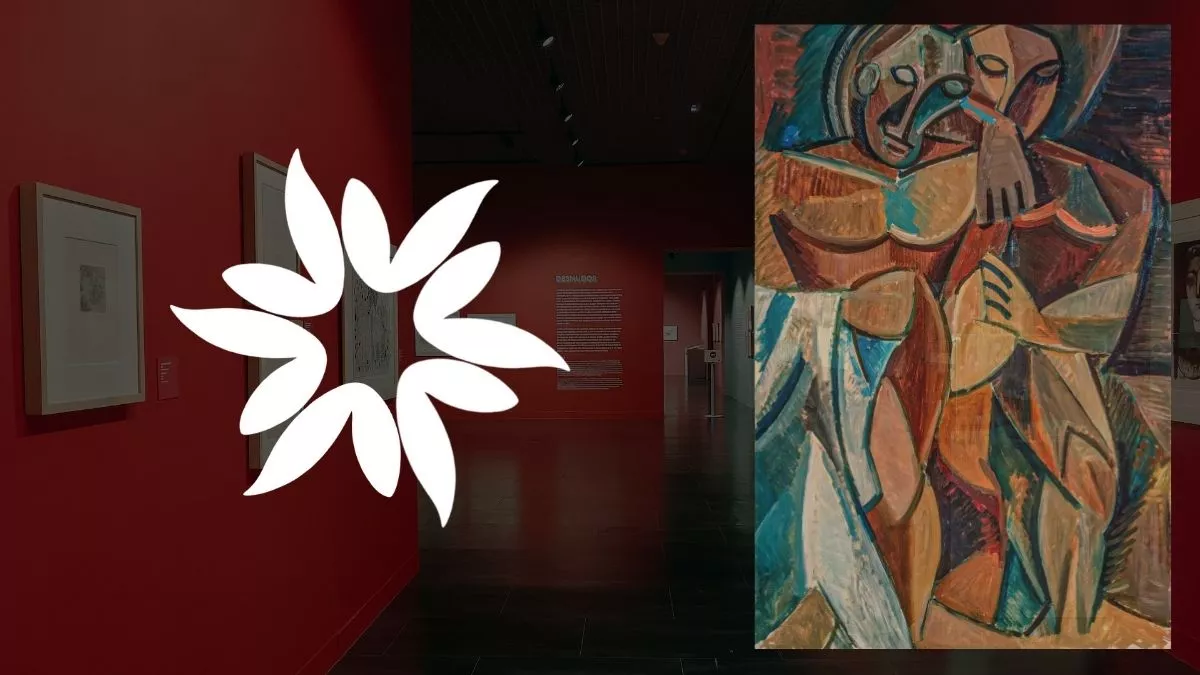Pablo Picasso. You’ve probably heard the name, even if you’re not an art buff. His paintings are iconic – bold, sometimes a little weird, but always captivating.
From his melancholic Blue Period to mind-bending Cubist experiments, Picasso’s work takes you on a journey, exploring both the depths of human emotion and the boundless possibilities of artistic expression.
Today, we’ll explore his iconic masterpieces, the stories behind them, and how he forever changed the way we see the world – and ourselves.
The Evolution of Picasso’s Artistic Journey
Picasso’s artistic evolution wasn’t a straight line but more like a roller coaster ride through a kaleidoscope of styles.
Each twist and turn reflected a new phase in his life and a restless desire to push the boundaries of art.
From the sad blues of his early years to the fragmented forms of Cubism and beyond, let’s look at the fascinating evolution of Picasso’s artistic vision.
Blue Period (1901-1904)
Imagine a world painted in shades of blue – not the bright, cheerful kind, but the deep, melancholic blues that reflect a heavy heart. That’s Picasso’s Blue Period in a nutshell.
It was a tough time for him following the suicide of his close friend, and his paintings mirrored that sadness.
During this phase, Picasso focused on people living on the fringes of society – the poor, the lonely, the forgotten. Picasso’s paintings weren’t only portraits, though; they were filled with empathy and a deep understanding of their struggles.
For example, “The Old Guitarist” is a picture of an elderly musician hunched over his instrument, his face etched with hardship. Or “La Vie,” a complex allegory of life and death that’ll leave you pondering its meaning long after seeing it.
These paintings are powerful, to say the least. They show us a side of humanity that’s often overlooked. It also reminds us that even in the darkest times, there’s still beauty and resilience to be found.
Rose Period (1904-1906)
Picasso’s palette lightened considerably after the sad blues of his earlier period. Think warmer tones, pinks, and oranges – a visual sigh of relief. This shift coincided with a happier time, which shows in his art.
While some pieces still linger with a hint of melancholy, there’s also a newfound sense of joy and playfulness.
Picasso became fascinated with circus performers and clowns, capturing their grace and underlying humanity.
Paintings like “Girl with a Mandolin” and “Family of Saltimbanques” are perfect examples – delicate and beautiful but with a touch of wistfulness that keeps you looking deeper.
It was like Picasso was finally letting a little light into his world, which made his art even more captivating.
Cubism (1907-1925)
In collaboration with Georges Braque, Picasso pioneered Cubism – a groundbreaking artistic movement that shattered traditional notions of perspective and representation.
Cubism wasn’t your typical “look and admire” kind of art. It invited viewers to participate actively, to piece together the fragmented forms and multiple perspectives, almost like solving a visual puzzle. In a sense, it was a whole new way of experiencing art.
It’s worth noting that two seminal works stand out as powerful examples of the transformative power of Cubism.
First, there’s “Les Demoiselles d’Avignon,” a daring and provocative painting that essentially marked the movement’s birth.
Then, of course, we have the monumental “Guernica,” a visceral anti-war statement that resonates today.
These paintings represented a fundamental shift in how artists approached the depiction of reality, which paved the way for a new era of artistic experimentation and expression.
Surrealism and Beyond
Even after revolutionizing the art world with Cubism, Picasso’s creative spirit remained restless. He fearlessly explored other styles, like Surrealism, capturing the dreamlike and the subconscious, and even revisited classical themes with a Neoclassical twist.
His paintings from this period, such as “The Dream,” a sensual and enigmatic portrait of his mistress Marie-Thérèse Walter, are rich in symbolism and hidden meanings. On the other hand, “The Weeping Woman,” a haunting depiction of grief, showcases his expressionist tendencies.
It’s clear that Picasso’s constant experimentation defined his artistic journey. He refused to be confined by any single style or movement, always finding new ways to express his vision and challenge the boundaries of art.
Fun Fact: Picasso was a child prodigy, completing his first painting at just nine years old!
Picasso’s Portraits: More Than Meets the Eye
Picasso’s portraits were about delving deeper, peeling back the layers to reveal the soul behind the eyes.
Whether he was painting his loved ones, fellow artists, or even historical figures, Picasso had the uncanny ability to capture the essence of a person – their personality, quirks, and inner life.
Take his famous portrait of Gertrude Stein, for instance. This American writer and art collector was a close friend of Picasso’s, and her portrait is a landmark in his Cubist period.
Now, it took a whopping 80 sittings to complete, and when critics questioned the likeness, Picasso famously said, “Everybody thinks she is not at all like her portrait, but never mind, in the end she will manage to look just like it.”
However, Picasso’s portraits weren’t always about challenging conventions. He could also be incredibly tender and intimate, especially when painting his loved ones.
In “Maya with Doll,” a father’s love shines through, capturing the innocence and playfulness of childhood.
High Stakes and Record-Breaking Sales
Let’s be honest: Picasso’s paintings aren’t exactly pocket change. They consistently reach astronomical prices at auction, proving time and again that he’s one of the most sought-after artists in history.
The appeal of owning a Picasso original is undeniable. Add in their scarcity and the weight of their historical significance, and you have a recipe for serious bidding wars among collectors.
To give you an idea, “Les Femmes d’Alger (Version O)” currently holds the record for the most expensive Picasso ever sold, reaching a staggering $179.4 million in 2015.
And it’s not the only one – other iconic works like “Nude, Green Leaves and Bust” and “Garçon à la pipe” also rank among the top 10 most expensive paintings ever sold.
Picasso Paintings for Sale: A Collector’s Dream
While owning an original Picasso might seem out of reach for most people, there’s a silver lining: Picasso was incredibly prolific and created an enormous amount of work throughout his life.
Thanks to this, a surprisingly wide variety of his pieces is available in the art market, making it more accessible than you might think to own a piece of his legacy.
Reputable galleries and auction houses like Sotheby’s and Christie’s regularly feature Picasso paintings and other creations, and they ensure authenticity and provenance for those seeking investment-grade art.
Right now, you might stumble upon anything from a vibrant still life estimated in the millions to a delicate early drawing that’s (relatively) more budget-friendly.
In fact, as of August 2024, Christie’s has a selection of Picasso’s works available, including a vibrant still life from his later years, estimated to fetch between $1.5 million and $2.5 million.
If you’re curious about exploring Picasso’s work without needing a seven-figure bank account, the world of prints and lithographs is a fantastic starting point. These offer a taste of his genius at a more approachable price point, often starting in the hundreds or thousands of dollars.
Picasso’s Influence on Modern Art
Picasso wasn’t your average painter – he was a revolutionary force in the art world. His artistic innovations sparked a creative wildfire that continues to burn bright today.
Take Cubism, for example. He and Braque completely reimagined how we see the world. Their fragmented forms and multiple viewpoints paved the way for abstract art, leading to movements like Futurism and Abstract Expressionism.
Even giants like Jackson Pollock stand on the shoulders of Picasso’s groundbreaking work.
And then there’s Surrealism. Picasso’s exploration of dreamlike imagery and the subconscious ignited the imaginations of artists like Salvador Dalí and René Magritte.
Dali’s and Magritte’s paintings, with their dreamlike scenes and unexpected twists, definitely show how Picasso’s early explorations of the subconscious paved the way for the Surrealist movement.
But Picasso wasn’t content to stay within the confines of painting. He fearlessly experimented with sculpture, collage, and ceramics, pushing the boundaries of each medium and inspiring countless others to do the same.
Many contemporary artists will tell you that his playful “anything goes” attitude remains a guiding light for them.
Iconic Picasso Paintings That Define His Legacy
Believe us, we wish we could compile a list of the top 100 Picasso works, but given the sheer volume and diversity of his art, it’s no walk in the park.
Still, certain paintings stand out as key moments in his artistic journey.
These masterpieces, celebrated for their creativity, emotional depth, and cultural impact, give us a fascinating glimpse into the genius behind his work.
Let’s take a closer look at a few of these iconic works:
- “Guernica”: This painting is a gut punch. Imagine a massive canvas filled with stark black-and-white imagery, twisted figures, and a palpable sense of chaos. That’s “Guernica.”
Picasso painted it as a response to the bombing of Guernica during the Spanish Civil War, and it remains one of the most powerful anti-war statements ever created.
- “Les Demoiselles d’Avignon”: Talk about a game-changer. This Cubist masterpiece shattered all the rules of perspective and representation, basically redefining how we see the human form.
Its angular shapes and fractured planes are still shockingly modern, even over a century later.
- “The Weeping Woman” is a haunting painting. Its distorted features and vibrant colors convey a raw sense of anguish and despair that captures the emotional toll of the Spanish Civil War.
It’s a powerful reminder of how deeply conflict impacts real people and their lives, making the cost of war feel all too real.
- “The Old Guitarist” is from Picasso’s Blue Period and is a real heartbreaker. The elongated figure and somber blue tones depict isolation and melancholy, inviting us to share in the musician’s quiet solitude.
It’s safe to say that the painting’s emotional intensity speaks volumes about the struggles of the human condition.
- “Girl Before a Mirror”: A fascinating look at identity and self-perception, this painting is classic Picasso.
Its contrasting colors and fragmented forms represent the duality of a young woman’s inner and outer selves, making us think about how we see ourselves versus how others see us.
Picasso’s Enduring Legacy
Picasso was no ordinary artist; he was a visionary who redefined the boundaries of artistic expression.
Even today, his paintings, sculptures, and ceramics continue to captivate and inspire, sparking conversations and challenging our perceptions.
In Picasso’s words, “Art washes away from the soul the dust of everyday life.” And his work continues to do just that, reminding us of the beauty, the pain, and the boundless possibilities of the human experience.
So, next time you come across a Picasso painting, have a moment to take it in – you might be surprised at how much it speaks to you.
By the way, if you’re fascinated by how art influences culture, you’ll want to check out our list of 20 movies inspired by famous artworks.








